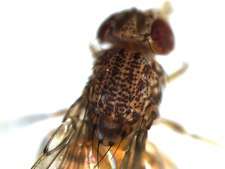Drosophila hydei
Drosophila hydei(mosca casera) is a species of Diptera, or the order of flies, in the family Drosophilidae. It is a species in the hydei species subgroup, a group in the repleta species group.[1] Bizarrely, it is also known for having approximately 23 mm long sperm, 10 times the length of the male's body.[2] Drosophila hydei are commonly found on compost piles worldwide, and can be rudimentarily identified by eye owing to their large size and variegated pigment pattern on the thorax. The name derives from Dr R. R. Hyde, who first discovered that the species was distinct from Drosophila repleta.[3] D. hydei are one of the more popular flies used as feeders in the pet trade. A few varieties are available, some flightless.
| Drosophila hydei | |
|---|---|
 | |
| Drosophila hydei | |
| Scientific classification | |
| Kingdom: | |
| Phylum: | |
| Class: | |
| Order: | |
| Family: | |
| Genus: | |
| Subgenus: | |
| Species: | Drosophila hydei |
| Binomial name | |
| Drosophila hydei Sturtevant, 1921 | |
Wild populations of D. hydei can be infected with Spiroplasma bacteria that defend the fly against parasitoid wasps.[4]
Gallery
 A Drosophila hydei female
A Drosophila hydei female Dorsal view of a D. hydei female showing the variegated pigment patterning on the thorax
Dorsal view of a D. hydei female showing the variegated pigment patterning on the thorax
References
- Greg S. Spicer; Scott Pitnick (1996). "Molecular Systematics of the Drosophila hydei Subgroup as Inferred from Mitochondrial DNA Sequences". J Mol Evol. 43 (3): 281–286. doi:10.1007/BF02338836. PDF Archived June 11, 2010, at the Wayback Machine
- Pitnick, S.; Markow, T.A. (1994). "Large-male advantages associated with costs of sperm production in Drosophila hydei, a species with giant sperm". Proc. Natl. Acad. Sci. USA. 91 (20): 9277–9281. doi:10.1073/pnas.91.20.9277. PMC 44795. PMID 7937755.
- Sturtevant, A. H. (1921). The North American Species of Drosophilia. Washington, DC: Carnegie Institute of Washington. p. 101.
- https://doi.org/10.1371/journal.pone.0012149
Further reading
- H. D. Berendes (1965). "Salivary gland function and chromosomal puffing patterns in Drosophila hydei". Chromosoma. 17 (1): 35–77. doi:10.1007/BF00285155.
- H. D. Berendes; H. G. Keyl (1967). "Distribution of DNA in Heterochromatin and Euchromatin of Polytene Nuclei of Drosophila hydei". Genetics. 57 (1): 1–13. PDF
- J. B. Boyd; H. D. Berendes; H. Boyd (1968). "Mass Preparation of Nuclei from the Larval Salivary Glands of Drosophila hydei". Journal of Cell Biology. 38 (2): 369–376. CiteSeerX 10.1.1.281.8496. doi:10.1083/jcb.38.2.369. PDF
| Wikimedia Commons has media related to Drosophila repleta hydei. |